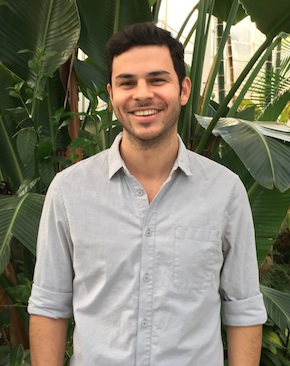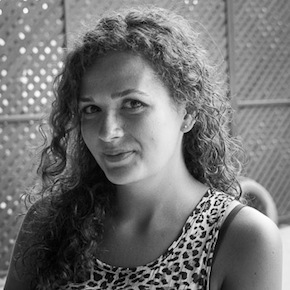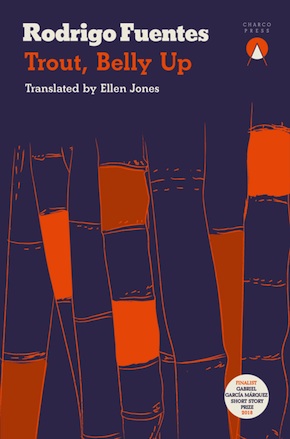The cow who wanted to be a dog
by Rodrigo FuentesIt was the sugarcane harvest and the fields were burning. You could see flames all the way from here to the mountains. Ash floated around all day, sticking to your skin, your moustache, your eyelashes. We were all black with it. On the fifth day it rained. It doesn’t rain in December, but that year it rained three days non-stop. The fields flooded, half-mud, half-ash. Nobody was working, nobody was cutting the cane. Those were strange days. That was when Perla was born – Perla, the cow who wanted to be a dog.
In my first drawing of Perla the cow, she appears in profile. Behind her, everything’s plastered with ash; her smile flashes bright and clear against the darkness. What do you think? I asked my son once I’d given it the finishing touches. He looked at the drawing and then turned to me with that face that reminds me of his mother. Don’t start getting attached, Dad, he said. It’s a cow. And with that he went out to cut the cane with the other workers, and left me tracing over her tail with a piece of charcoal.
Perla’s mother didn’t want her. From day one she refused to let her suckle. Perla would approach, gently as can be, and her mother would shove her away with a swing of the hips. Bam! and off little Perla would go. She began to lose weight. I noticed right away and took her over to other cows who had calves, but none of them wanted her either. I went to talk to the boss. She needs a bottle, I told him, one of those huge ones, so I can give her some warm milk. The boss, Don Henrik, looked at me askance, but he trusted me. Within two days I was feeding her, letting her suck on an enormous bottle that she gulped from eagerly.
It’s a strange sight, a calf balancing on two legs. Don’t ask me how, but whenever I came up to the garden and spotted them in the distance I swear those two rascals would be killing themselves laughing.”
We tried to put her back with the others, but Perla didn’t get on with the herd and the herd didn’t get on with Perla. Don Henrik was sympathetic. Bring her to the garden at the hacienda, he said. We’ll look after her there. And it was there that Perla met Blue, the mongrel who’d appeared out of the blue on the farm a couple of years back. They were instant pals. Pure chemistry. Nothing romantic, though, they were just friends. How they played, how they chased around in that garden, Perla and Blue.
She learned to stand on two legs, after seeing Blue do it so often. The spitting image, if you ask me. Because she even did the same little dance to keep herself upright, moving one little foot forwards and the other back, one forwards, one back. It’s a strange sight, a calf balancing on two legs. They’d spend the whole day together, laughing together even. Don’t ask me how, but whenever I came up to the garden and spotted them in the distance I swear those two rascals would be killing themselves laughing.
We grew melons on our farm, but it was surrounded by expanses of sugarcane fields belonging to the plantation. My son worked those fields, him and all the other day labourers. The work was hard, hacking away with a machete all day, spurred on by pills handed out by their supervisor. Amphetamines, that’s what he used to give them. By the time they got home their pupils would be enormous. You can see those eyes, those wild pupils, in a portrait I did called Son, again, though my son wasn’t happy with it. It’s so ugly, Dad. He took it badly. Held it away from him, pinching just the edge. I told him it wasn’t the drawing’s fault: blame your mother and me, don’t blame the art. He let go of the drawing, let it fall to the floor, and left my hut without another word. Those pills have robbed him of his sense of humour.
She loved being scratched behind the ears and would moo gently if you showed her some affection. Blue would throw himself down next to her, the two of them adopting the same position.”
The plantation workers used to pass by our farm at the end of the day, on the way back to their shacks. That’s how they became fond of Perla, who used to come out into the garden to greet them. They were all puffy from work and from those pills, but Perla would wag her tail, smile at them, stand on two legs to send them on their way. Dance, they’d tell her. Dance, shouted anyone with energy to spare, and Perla would reward them with a little step to the front, a little step to the back, another to the front, another to the back.
In any case, Perla started to grow. In less than a year she was full-size. She’d still go out onto the terrace to rest, legs splayed, nose flat to the bricks, eyes squinting in pure pleasure. She loved being scratched behind the ears and would moo gently if you showed her some affection. Blue would throw himself down next to her, the two of them adopting the same position. They were still pals, but when they played rough and tumble you could tell the dog was more careful, wary of Perla’s heft. The cow didn’t stand on two legs much anymore, she was too big for that now, but she’d still give the funniest little jumps.
The same year that Perla stopped growing, the first mechanised harvesters arrived at the plantation. They did the work of a hundred men in half the time. How they hacked away, those miserable machines, how they cut through the sugarcane with their steel blades. From one day to the next they started letting workers go, but the union stood firm and by the end of the year all hell broke loose. They chose the harvest period to put down their machetes and go on strike, marching together through the cane fields.
They went past the hacienda garden that day, everyone rowdy, both young and old, my son marching and yelling along with the rest of them. This was Perla’s moment to shine. She jumped neatly over the hedge to be among the crowd, mooing in the friendliest way and letting everyone pet her. She wagged her tail, nodded her head up and down and mooed for the sheer joy of it.

Volcanoes of Guatemala seen from the top of the Santa Maria volcano in Quetzaltenango. ‘CrazyKnight’/Wikimedia Commons
It was finally clear, the thing we’d all suspected: Perla had sided with the workers.
The months that followed were pretty rough. People started to set fire to the new machines. They got hold of the first one in January, on a night when a whole warehouse went up in flames. You could see them from here, and the sirens sounded like the sugarcane itself was wailing at the top of its lungs. Don Henrik was staying on the hacienda at the time, and he went out onto the terrace to see what was going on. The two of us stood there very quietly, within the shelter of our own farm. You stay here with me, he said. Don’t even think about getting involved. I wasn’t totally past it yet, but most of my protesting days were behind me. I’d given enough of myself to the union in the city. It was my son’s turn to put up a fight. The flames lit up the night: in the darkness I spotted Perla’s shining gaze, her eyes dazzling in the firelight.
What happened next was only a matter of time. The mill owners brought in people from out east to patrol the sugarcane. These were bad people. Not that I’ve got anything against easterners, but these guys had murderous old mugs. It wasn’t long before the union leaders started to fall. They shot two of the top guys, right there in their own huts. They killed the son of a third, just a kid who’d got himself mixed up in everything. So it looked like that would be the end of the whole mess, after those three hits took place in the space of just a few days.
My drawings from that time are pretty murky-looking – it’s like the charcoal itself was pissed off with the blank page. Perla’s the only one I’ve got a good likeness of, her smile and energy anyway, because that cow was unusually restless, coming and going more like a dog than a heifer.
By the time some guys formed a Torch of Justice to put right all their grievances, people were already talking about breaking the strike and going back to work. There’d been food shortages. But the rumour about the Torch spread like fire in an open cane field: there’s twenty of them, a few more maybe, poor wretches all of them, people started to say, but they’re finally evening the score.
That dog had a couple of friends among the sugarcane cutters; I suppose in the end he was a card-carrying member of the Torch of Justice himself. He was faithful, Blue: faithful to chaos, because he had mischief in his soul.”
Ghosts, that’s what they were like. Because the poor bastards would run back and forth through the sugarcane, materialising with their torches and then vanishing a split second later, leaving nothing but fire and chaos. The hired guns would leave by one side of the farm and the Torch would appear on the other: they stole fertiliser, jammed the machines in the mill, set fire to the mechanised harvesters. The mill was hit hard that season, what with so many fires and break-ins.
I knew who they were because of Blue. That dog had a couple of friends among the sugarcane cutters; I suppose in the end he was a card-carrying member of the Torch of Justice himself. He was faithful, Blue: faithful to chaos, because he had mischief in his soul. His coat was a cinnamon colour but he started to turn up in the mornings completely black, covered in mud from nose to tail. Only his teeth were white, and the little scamp would shoot me a look of pure glee. Blue, I’d shout, but before I could catch him he’d already be off into the undergrowth.
One night of a full moon, I heard the patter of his paws. I could always tell it was Blue because he had a bad leg and lolloped as he ran. When I went out to have a look, he was arriving with two of those down-and-out torch bearers, him leading the way: that good-for-nothing had brought them back to the boss’s hacienda. It took me a second to realise that one of them was my son. They went straight into the woodshed opposite the garden terrace to hide.
By the time the hired guns arrived everything was quiet; all I knew was we needed to keep a low profile. These guys were pissed off, wanted to hammer a lesson into those wretches. And there was no sign of the boss, no one else to see them off.
Fucking Blue, I thought. And that fucking son of mine. Fucking sugarcane, I thought too.
from ‘Out of the Blue, Perla’ in Trout, Belly Up by Rodrigo Fuentes, translated by Ellen Jones (Charco Press, £8.99)
 Rodrigo Fuentes (born 1984) is one of the most prominent names among the new generation of Guatemalan writers. He won the Carátula Central American Short Story Prize in 2014 as well as the Juegos Florales of Quetzaltenango Short Story Prize (2008). He is the co-founder and editor of the magazine Suelta and of the digital publishing house and literary journal Traviesa. Trout, Belly Up was shortlisted for the 2018 Premio Hispanoamericano de Cuento Gabriel García Márquez, the most prestigious prize awarded to short-story writers in Latin America. It has been published in Guatemala, Bolivia, Chile and Colombia, as well as in France. Rodrigo currently lectures at the College of the Holy Cross in the United States, and lives between Providence and Guatemala. Trout, Belly Up, his first book to appear in English, is published in paperback by Charco Press, translated by Ellen Jones.
Rodrigo Fuentes (born 1984) is one of the most prominent names among the new generation of Guatemalan writers. He won the Carátula Central American Short Story Prize in 2014 as well as the Juegos Florales of Quetzaltenango Short Story Prize (2008). He is the co-founder and editor of the magazine Suelta and of the digital publishing house and literary journal Traviesa. Trout, Belly Up was shortlisted for the 2018 Premio Hispanoamericano de Cuento Gabriel García Márquez, the most prestigious prize awarded to short-story writers in Latin America. It has been published in Guatemala, Bolivia, Chile and Colombia, as well as in France. Rodrigo currently lectures at the College of the Holy Cross in the United States, and lives between Providence and Guatemala. Trout, Belly Up, his first book to appear in English, is published in paperback by Charco Press, translated by Ellen Jones.
Read more
@CharcoPress

Ellen Jones is a researcher and translator based in London. She has a PhD from Queen Mary University of London and writes about multilingualism and translation in contemporary Latin American literature. Her reviews have appeared in publications including the Times Literary Supplement and The Los Angeles Review of Books, and her translations in publications including the Guardian and Latin American Literature Today. She has been Criticism Editor at Asymptote since 2014.
@ellen_c_jones



